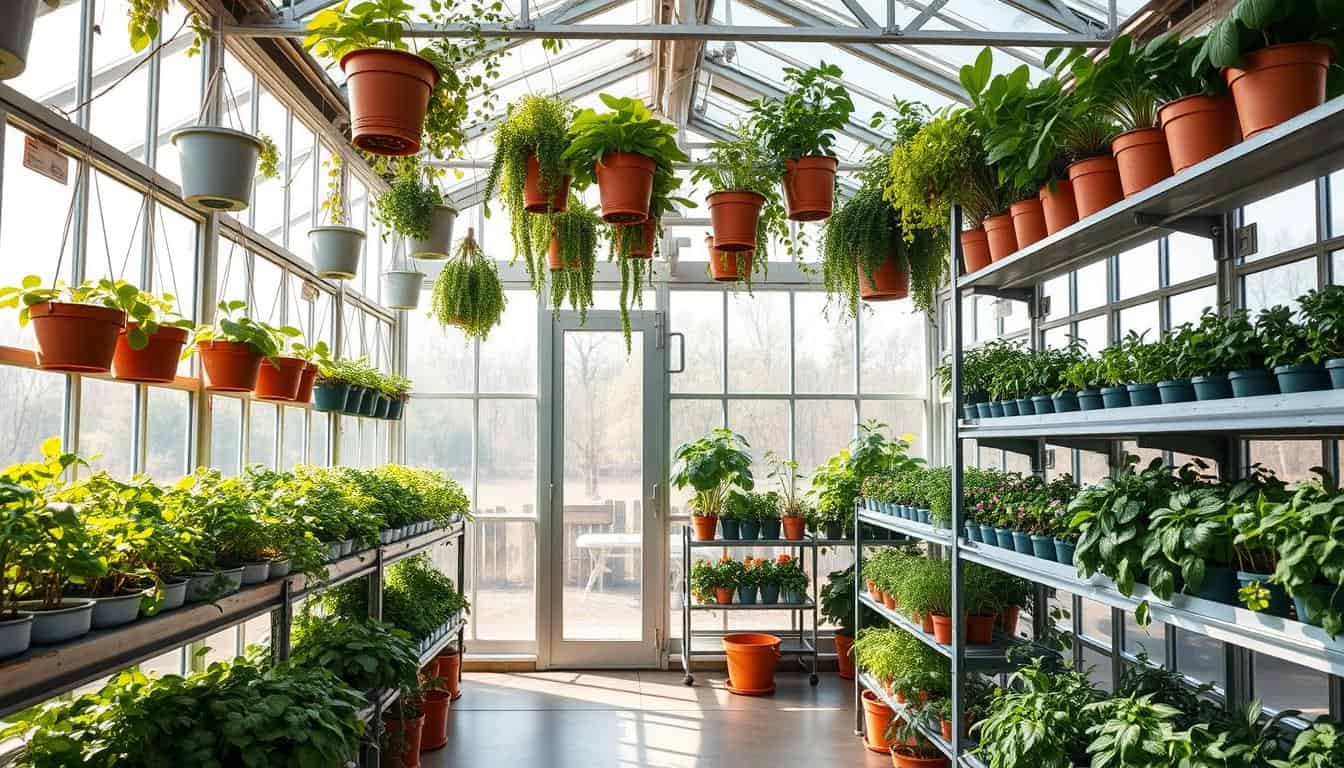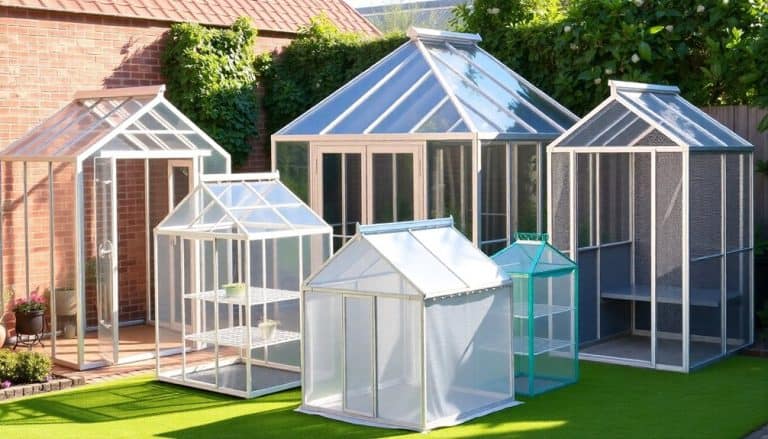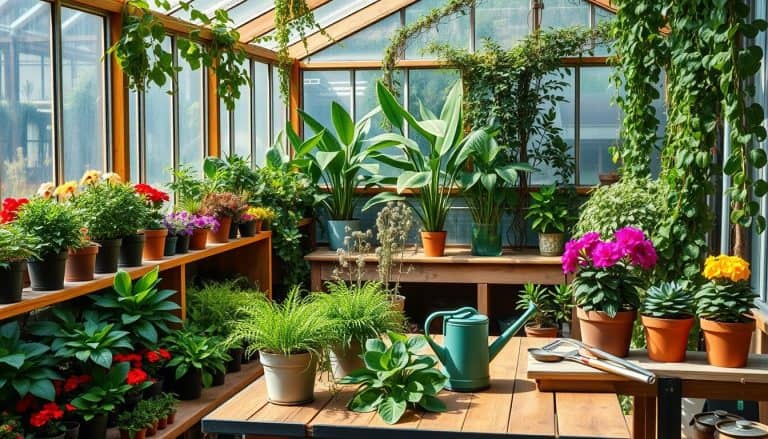This website contains affiliate links. Some products are gifted by the brand to test. As an Amazon Associate, I earn from qualifying purchases. The content on this website was created with the help of AI.
Greenhouses with smart tech can boost productivity by 30%. This shows the huge potential of optimizing greenhouse space. Efficient layouts and vertical farming can transform plant growing.
Greenhouse layout is key to maximizing space use. Peninsula designs and automated shelving improve organization. These strategies can greatly increase production.
Vertical farming lets us grow more in less space. It’s a game-changer for greenhouse optimization.
Smart irrigation systems cut water use by 90%. This saves resources and improves plant health. LED grow lights use 60% less energy than regular ones.
These technologies create a sustainable and productive greenhouse. They’re essential for modern plant cultivation.
Key Takeaways
- Smart technology can increase greenhouse productivity by 30%
- Efficient layouts and vertical farming maximize space utilization
- Automated shelving improves organization and flexibility
- Smart irrigation systems can reduce water usage by 90%
- LED grow lights offer 60% energy savings over traditional lighting
- Hydroponic systems can accelerate plant growth by 30-50%
Understanding Greenhouse Space Fundamentals
A solid grasp of space basics is key for effective greenhouse layout. We’ll explore crucial aspects for setting up your greenhouse. This ensures optimal plant growth and efficient space use.
Measuring Your Growing Area
Accurate measurements are vital for planning your greenhouse. Note the length, width, and height to determine total growing area. This info guides bench selection and placement.
Assessing Environmental Conditions
Environmental factors are crucial for greenhouse success. Consider sun exposure, wind patterns, and temperature extremes in your region. Aim for a southern orientation for optimal sunlight.
In snowy areas, ensure your structure can handle heavy loads. This prevents damage during winter months.
Identifying Space Constraints
Recognize potential limitations in your greenhouse. Irregular shapes or structural elements may affect your layout. Plan for accessibility, including workspaces and storage areas.
Consider vertical gardening to maximize space efficiency. This technique allows you to grow more in limited areas.
| Bench Type | Benefits | Best Use |
|---|---|---|
| Aluminum | Low maintenance, suitable for humid environments | General purpose |
| Galvanized Steel | Strong, supports heavy loads | Large plants, equipment |
| Plastic | Lightweight, easy to clean, chemical-resistant | Seedlings, small plants |
Understanding these basics helps create an efficient greenhouse layout. It optimizes plant growth and simplifies maintenance. Proper planning of environmental systems ensures ideal growing conditions year-round.
Creating an Efficient Layout Design
A well-planned greenhouse layout boosts crop yield and maximizes space. Let’s explore designs that enhance productivity and plant growth.
Consider these factors when planning your layout:
- Sunlight exposure
- Plant spacing for air circulation
- Vertical gardening options
- Zoning for uniform growth requirements
- Succession planting for continuous harvest
A smart layout increases light exposure and plant growth. In the Northern Hemisphere, a south-facing orientation often works best for sunlight.
Crop scheduling is vital for space utilization. Succession planting ensures continuous harvests throughout the season. This method involves planting crops at staggered intervals.
Here’s a sample layout that maximizes space and yield:
| Layout Component | Quantity | Weekly Profit | Seasonal Profit |
|---|---|---|---|
| Ancient Fruit | 116 plants | 267,960g | 1,071,840g |
| Iridium Sprinklers | 6 | N/A | N/A |
| Fruit Trees | 30 | 115,710g | 462,840g |
| Hops | 74 | N/A | N/A |
This layout blends crops to boost profits and use space wisely. Vertical elements like fruit trees and hops increase yield without taking up floor space.
Vertical Growing Solutions for Space Maximization
Vertical farming optimizes greenhouse space by growing plants upwards. This method increases crop yields and maximizes limited areas. Let’s explore effective vertical growing solutions for your greenhouse production.
Implementing Vertical Shelving Systems
Vertical shelving systems maximize growing space in greenhouses. These structures stack plants on multiple levels, increasing crops per square foot. Hydroponic towers and planter walls offer efficient use of space and resources.
Choosing Plants for Vertical Gardens
Selecting the right plants is crucial for vertical gardens. Vining plants like peas, tomatoes, squash, and grapes thrive in this environment. These plants can be trained to grow upwards, producing bountiful harvests.
Installing Hanging Systems and Trellises
Hanging systems and trellises support climbing plants in vertical farming. They create extra growing space without using valuable floor area. These systems increase air circulation and make watering and harvesting easier.
| Vertical Farming Method | Benefits | Challenges |
|---|---|---|
| Hydroponics | Precise nutrient control, efficient water use | Initial setup costs, technical expertise required |
| Aeroponics | Quick plant growth, minimal water usage | High energy consumption, system complexity |
| Aquaponics | Sustainable closed-loop ecosystem | Balancing fish and plant needs, system maintenance |
Vertical farming techniques transform greenhouses into highly productive spaces. These methods optimize greenhouse space and contribute to sustainable agriculture. They ensure a bright future for urban farming.
Advanced Techniques for Optimizing Greenhouse Space
Advanced techniques can boost greenhouse productivity significantly. Hydroponics is a game-changer, allowing plants to grow without soil. This method saves space, increases yield, and conserves water.
LED grow lights have transformed plant light exposure. They provide tailored light spectrums, promoting faster growth. These energy-efficient fixtures can boost productivity by up to 25% compared to traditional lighting.
Automation tools are now essential in greenhouse operations. Timers for watering systems and smart thermostats maintain ideal growing conditions. These technologies save time and ensure consistent plant care.
Integrated pest management is crucial for advanced greenhouse strategies. We use biological control methods, introducing beneficial insects like Stratiolaelaps scimitus. This approach reduces chemical pesticide use and promotes a healthier environment.
| Technique | Benefits | Efficiency Increase |
|---|---|---|
| Hydroponics | Space-saving, water conservation | 40% |
| LED Grow Lights | Energy-efficient, tailored spectrum | 25% |
| Automation Tools | Consistent care, time-saving | 30% |
| Integrated Pest Management | Reduced chemical use, healthier environment | 20% |
Combining these techniques optimizes greenhouse space effectively. It improves overall productivity and sustainability in greenhouse operations.
Smart Zoning and Plant Placement Strategies
Smart zoning and plant placement are key to effective greenhouse management. Grouping plants with similar needs creates an optimal environment for each crop. This approach maximizes space efficiency and supports healthy plant growth.
Temperature-Based Zoning
Divide your greenhouse into temperature zones to cater to diverse plant needs. Place heat-loving crops near heat sources or in sunny spots. Cool-season vegetables can thrive in shadier areas.
This approach simplifies environmental control systems. It also supports effective crop scheduling throughout the year.
Light Requirement Grouping
Organize plants based on their light needs. Position sun-loving plants near south-facing walls or windows for maximum sunlight. Use shelving units or hanging systems for shade-tolerant species.
This method ensures each plant receives the right amount of light. It helps create optimal growing conditions for various plant types.
Humidity Level Management
Group plants with similar humidity requirements together. Create microclimates using misting systems or humidity trays for moisture-loving plants. Keep drought-tolerant species separate to prevent overwatering.
This zoning technique allows for precise environmental control. It promotes healthy growth across different plant varieties.
| Zone Type | Characteristics | Suitable Plants |
|---|---|---|
| Hot Zone | High temperature, bright light | Tomatoes, peppers, eggplants |
| Cool Zone | Lower temperature, partial shade | Lettuce, spinach, herbs |
| Humid Zone | High humidity, moderate light | Ferns, tropical plants |
| Dry Zone | Low humidity, bright light | Succulents, cacti |
Smart zoning creates an efficient greenhouse layout that boosts plant growth. It simplifies maintenance tasks and improves crop yield. This approach enhances overall greenhouse productivity and success.
Implementing Space-Efficient Irrigation Systems
Space-efficient irrigation systems boost greenhouse operations. Some facilities waste up to 50% of their irrigation water. Smart solutions can cut water waste and boost efficiency.
Drip irrigation and soaker hoses deliver water straight to plant roots. These systems save space and water. Pulse irrigation can cut water use by 25%.

Granular irrigation zoning with multiple valves improves control and efficiency. It allows precise water distribution based on plant needs. Closed-loop systems can reuse all irrigation water, reducing runoff.
Greenhouse automation helps manage these systems well. Environmental controls monitor soil moisture and automate watering schedules. This ensures plants get the right amount of water when needed.
| Irrigation System | Water Efficiency | Space Efficiency |
|---|---|---|
| Drip Irrigation | High | High |
| Soaker Hoses | Medium | High |
| Overhead Sprinklers | Low | Low |
| Subirrigation | High | Medium |
Combining space-efficient irrigation with automation creates a sustainable growing environment. This approach boosts productivity and conserves resources. It’s a win-win for growers and the environment.
Maximizing Light Distribution and Efficiency
Light is vital for greenhouse plants to thrive. Let’s explore ways to boost light distribution and efficiency in your greenhouse.
Using Reflective Materials
Reflective materials can greatly increase light for your plants. White paint or Mylar sheets are excellent for this purpose. They help spread light evenly, ensuring all plants get enough exposure.
Optimizing Natural Light Exposure
Smart plant placement is key for natural light use. Put taller plants at the back or sides of your greenhouse. This prevents shading of shorter plants and improves light reach.
Strategic Artificial Lighting Placement
Adding artificial lights can extend growing hours and boost plant growth. LED grow lights are energy-efficient for greenhouses. The GLASE consortium is working on better light control methods for energy savings.
Proper light placement is crucial. Many growers don’t install enough fixtures for optimal growth. Better positioning and brightness adjustments can improve light spread with fewer fixtures.
Light diffusion is key for even exposure and plant growth. Some LED companies are creating tech to scatter light like sunlight. This can boost photosynthesis and increase plant production in your greenhouse.
Storage Solutions and Tool Organization

Smart storage and tool organization are key to an efficient greenhouse layout. We’ve gathered tips from 15 organic farms to help you maximize your growing area. These insights will help you create a more productive space.
Use vertical space for greenhouse organization. Install shelves or pegboards on walls to store tools and supplies. Hooks, bins, and labeled containers keep items organized and easy to reach.
Create a zoning system in your greenhouse. Designate areas for storage, soil prep, seeding, and plant growth. This method improves organization and promotes optimal growing conditions.
- Install wall-mounted shelves for small greenhouses
- Use rolling benches or pre-built shelving units
- Implement removable shelves for flexibility
- Utilize combination staging for dual functionality
Multi-purpose potting benches are great for optimizing greenhouse space. They provide a workspace and storage for pots and tools. Ideal benches are 32-36 inches tall and 42-48 inches wide.
| Storage Solution | Benefits |
|---|---|
| Vertical Shelving | Maximizes vertical space, improves organization |
| Wall-mounted Pegboards | Easy tool access, customizable layout |
| Multi-purpose Benches | Workspace and storage in one, space-efficient |
| Hanging Baskets | Utilizes ceiling space, ideal for trailing plants |
These storage solutions will create a more organized and efficient greenhouse layout. You’ll have more time to nurture your plants and enjoy your green space.
Environmental Control Systems for Space Optimization
Environmental control systems boost greenhouse space efficiency. They create ideal growing conditions throughout the greenhouse. This allows for better use of available space.
Temperature Management Tools
The right temperature is vital for plant growth. Hot water pipes, boilers, or electric heat pumps regulate greenhouse temperatures. These tools create ideal conditions for various crops.
With proper temperature control, we can grow different plants in the same space. This diversity maximizes greenhouse potential.
Humidity Control Equipment
Proper humidity prevents mold and supports plant transpiration. Dehumidifiers are essential for managing moisture levels. Controlled humidity allows for denser plant growth without increasing disease risk.
Ventilation System Layout
A good ventilation system ensures even airflow in the greenhouse. Fans and vents create a uniform growing environment. This setup helps use every corner of the space effectively.
Greenhouse automation has changed how we manage environmental systems. Sensors collect crop data, while controllers automate tasks. This tech coordinates hundreds of devices to boost yields.
Advanced systems give better control over crop growth. They make growing more predictable, profitable, and eco-friendly. This approach maximizes space and enhances overall productivity.
Space-Saving Hydroponic Systems
Hydroponics offers a smart way to maximize greenhouse space. This soil-free method packs more plants into limited areas. It boosts efficiency and yields in small spaces.
Vertical farming techniques can turn tiny nooks into productive growing zones. These methods transform unused areas into thriving plant habitats.
Let’s explore some space-saving hydroponic systems:
- Nutrient Film Technique (NFT): This system uses shallow channels to circulate nutrient-rich water, ideal for leafy greens and herbs.
- Deep Water Culture (DWC): Plants float on nutrient solution, perfect for larger crops like tomatoes and cucumbers.
- Vertical Towers: These compact units can grow up to 40 plants in a small footprint, ideal for tight spaces.
Hydroponic systems with LED grow lights speed up harvest cycles. They promote healthier plant growth and allow vertical stacking of crops.
This combo can double or triple growing capacity. It does so without expanding the greenhouse footprint.
| Hydroponic System | Space Efficiency | Suitable Crops |
|---|---|---|
| NFT | High | Lettuce, Herbs |
| DWC | Medium | Tomatoes, Peppers |
| Vertical Towers | Very High | Strawberries, Spinach |
Space-saving hydroponic systems can revolutionize greenhouses. They create highly efficient growing environments. Every square foot becomes a productive space.
Seasonal Planning and Crop Rotation
Smart seasonal planning and crop rotation are key to successful greenhouse management. These strategies help maximize space and keep plants healthy. We adapt our layout and growing methods throughout the year.
Winter Space Utilization
In cold months, we protect sensitive plants by moving them near heat sources. We use crop scheduling to maintain production. Winter is perfect for experimenting with cover crops like daikon radishes.
These radishes break up compacted soil, improving its texture for spring planting. This preparation ensures better growing conditions for the upcoming season.
Summer Growing Arrangements
As it gets warmer, we move heat-loving plants to sunnier areas. Our crop rotation plan prevents planting the same family in one spot repeatedly.
This practice helps avoid soil-borne diseases. Succession sowing extends the growing season and maximizes space use.
Transition Period Management
Times between seasons are vital for continuous production. We adjust pest management strategies and add cover crops like hairy vetch.
Vetch adds nitrogen to the soil and naturally prevents diseases in nightshades. We analyze past data to improve our crop rotation plans.
This analysis helps us optimize yield and sustainability in our greenhouse. We continually refine our methods for better results.




